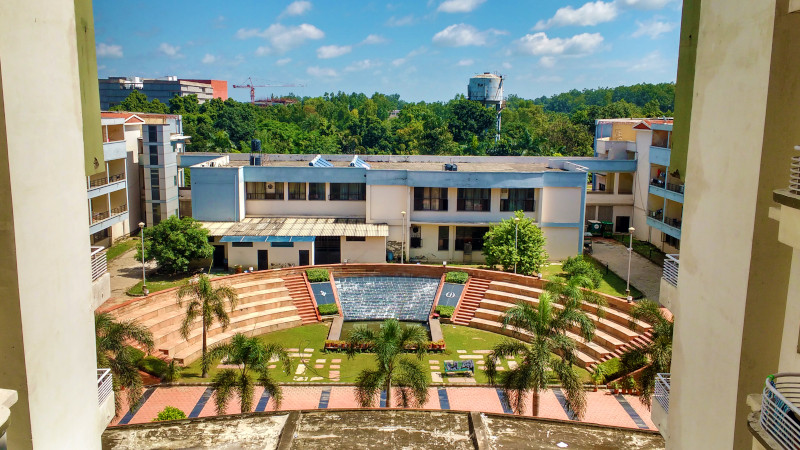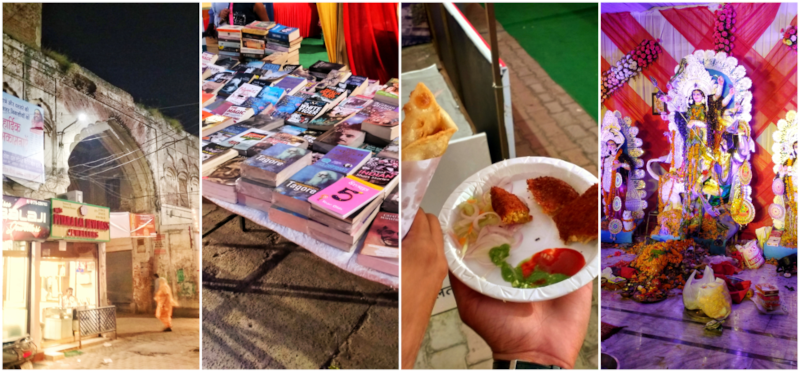
Ye Jo Khushi
Ever since my schooldays I have loved October. To me it meant the end of my second terminal examinations, a thing which I used to do better than I supposedly do now in college. I wasn’t really that afraid of the papers – I enjoyed it. The weather was better, afternoons less hot and I could laze around the house reading, watching TV or just day dreaming, counting days left until Pujo and talking to myself while others slept. There was not much to do. I used to look forward to the Pujo edition of Graphiti which used to come with The Telegraph. Stories of old, doodles by Biplab Deb and amusing myself with the repartee of the columnists. Derek still used to maintain his quizzing column with occasional questions from his father’s DI Quiz. Pujo for Bengalis is not only restricted to devotion – it’s an amalgamation of spending days shopping when even the most serious and easily irritable Baba left his newspaper or sports to lend his decision (and open his wallet) on the quality and showed his bargaining prowess (which until then was a quality only accorded to the missus of the house), of being carefree and given the freedom to stay until 8 at night, of being given an allowance for Pujo, of binge eating on golgappas, ice creams, chats, chowmein and not being scolded for it. To some it also meant trying to find that someone special in the crowds of the pandal and spending hours dreaming. It was when the word crush just meant a physical activity and infatuation was yet to come into my vocabulary. The disappointment was never to last long – there were many pandals, many hopes, many stories yet to be written. Bengalis have humanized their favourite deity – goddess Durga and is worshipped as much as demon-slayer, bringer of justice as a daughter returning to her home, Earth with her children, their mama bari. To me it also represented a time when social networks were yet to pervade our lives and special Pujo ads meant for a specific demographic didn’t attract FIRs as it does now. So much for being connected!
That was home. Now, I am in college and since 2016, I have missed Pujo. The first year was difficult. My roommates had left, the campus was almost empty and the mess stopped serving eggs because of Navratri (a tradition which even now in 2018 I have not been able to adapt to – Pujo and no non-veg? Atrocious! Revolting!). I was pretty much alone and sad. Used to spend my days watching Star Ananda in the evenings and listening to Bangla songs to get over my lonely life. It was not homesickness, it still isn’t. The environment was what I missed.
Second year too went by. Not too much sad now. Getting used to it. Continued to pester (and perhaps annoy) my friends to send me photos and videos from wherever they are. I have kept up with this tradition ever since. Sitting in my room, I saw pujos of Jamshedpur, Bombay and Delhi NCR. I cannot be thankful to them enough. Every day after coming back from my classes, those notifications of photos and videos would make my day. On doshomi, I took a photo of mine in a red kurta and uploaded on Instagram and Facebook. Shouldn’t have. I still used to be active on those last year. The photo still exists as my own contact image.
Third Year. To be honest, I didn’t really care enough for Pujo. My memory of it has faded and with it my longing. Still I was looking forward for October. Elixir was at the end of the month, the nights were becoming chilly, days were shorter, I could snug in comfortably in my welcoming bed and read or watch something – a myriad of possibilities. Pujo was not even on my mind. Instead I was looing forward for the Friday when it would be Doshomi. Extended weekend and less people on campus. Perfect!
This year was different.
The previous years, I had searched for Pujos in Patiala. Nada. Not even a single hit on Google. This time I had a fellow Bong friend who too was missing Pujos this time (he would have been in Bombay otherwise). It was his first time and the hope of attending a Pujo in his eyes were evident. I was unfazed. He was not. After much asking and talking he found out two Pujos happen in Patiala – one in Qila Chowk and the other in Patiala Cantonment (I knew about this one but was apprehensive of entering a security establishment in Punjab giving Pujo as the reason).
Saptami - 16th October
Baba had just flushed in some money into my account (Pujo allowance) and on Saptami, we went to Qila Chowk, in the old quarters of Patiala. Navigating through the narrow streets with its jewelry, Punjabi jutti, clothes, karyana stores and having a rosogollas at the old Jaggi near AC Market, we found it.
The place used to be the entrance of the fort of the erstwhile royal family of Patiala – Qila Mubarak (Fort Congratulations). It was dark. But the damage to the 18th century fortress was evident – in front of the square or Chowk was a temple, the rest of it covered with shops on four sides, their signage covering the vast arched entrance to the fort. The people were unaware. Or perhaps were so used to their heritage in their daily lives that preservation never came to their mind. The left side of the Chowk was occupied by street food stalls of chat, champ and surprisingly dosa. They weren’t too crowded. The plastic chairs were empty and the owners were eager for business. The people passed them by and the stoves were yet to be lighted.
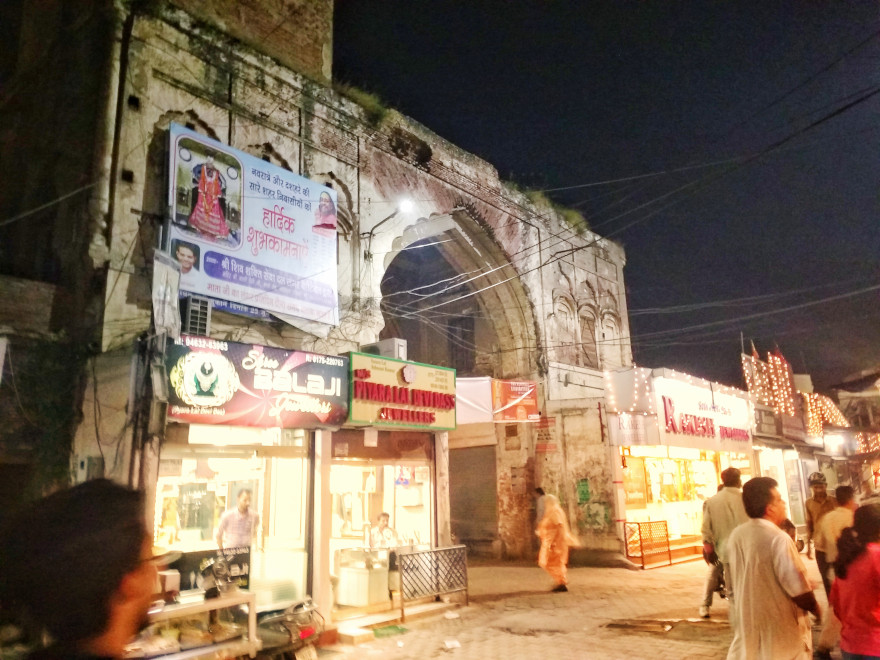
The red brick structure was built in 1763 in Sikh architectural style by the founder of the Patiala dynasty, Baba Ala Singh. For centuries it was the seat of power and the first fort of the city. Now, it sits at the intersection of three major commercial spines – Gur Mandi, Bajaja Bazaar and Shah Nashin Bazaar. I entered the gate of the fort and looked up to see a fine circular stucco decoration half of which had disintegrated. Further on, it was dark, empty. Outside the entrance there was a sign – Qila Mubarak. Patiala Heritage. The sign had faded.

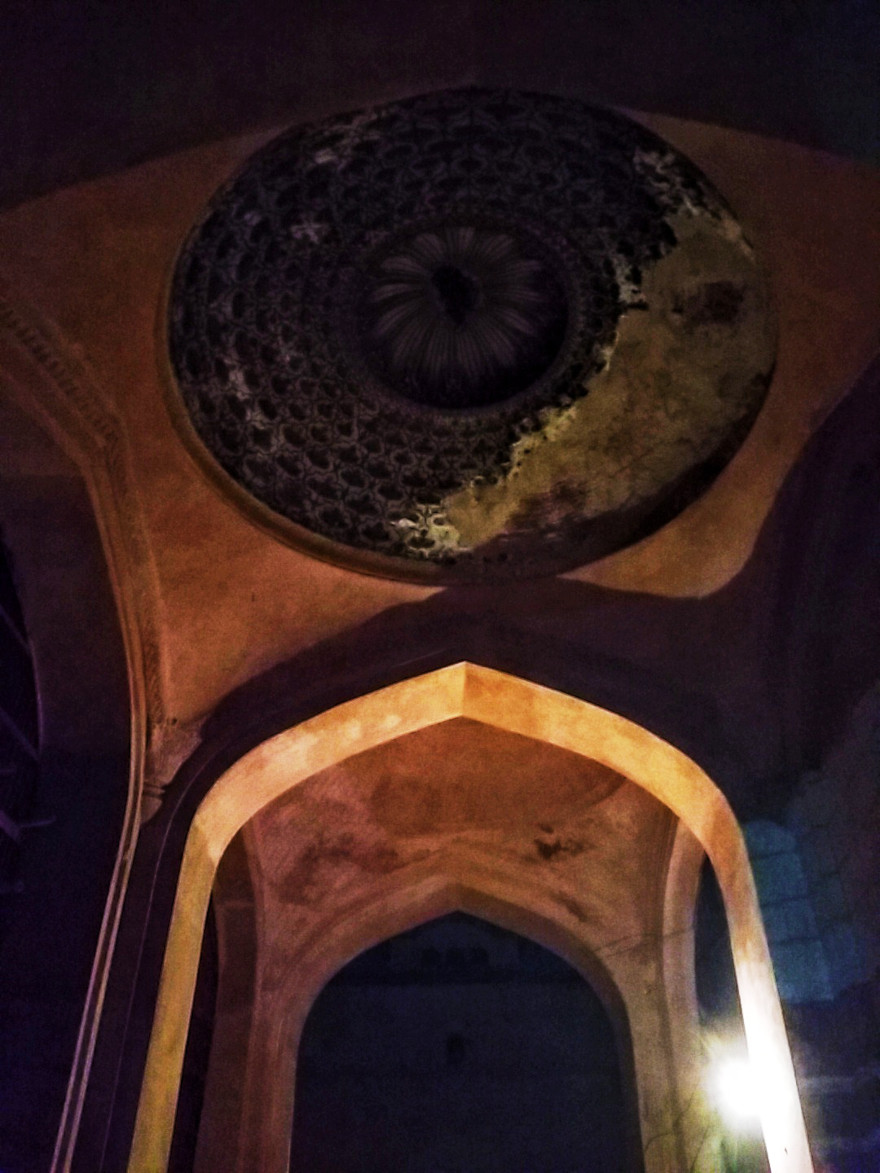
If it wasn’t for the Pujo, I wouldn’t have visited. In all my life I have never seen such a quiet Durga Pujo. Organized the local Bengalis who in an earlier time had migrated to work here as jewelry craftsmen and other small-time jobs, the absence of a Dhaki was a solemn affair. Perhaps their years of living in Punjab and learning the ways of the locals or even the monetary affair made the exclusion of the Dhaki a bit more plausible. Seeing thakur after 3 years was overwhelming for me. I was struck by her unwavering gaze, that barely noticeable smile and her towering yet benevolent figure. Durga is a mother goddess, her protective form willing to unleash against the wrong. Joined my palms, bowed before her and prayed. I must have stood transfixed for quite a few minutes before my friend nudged me.
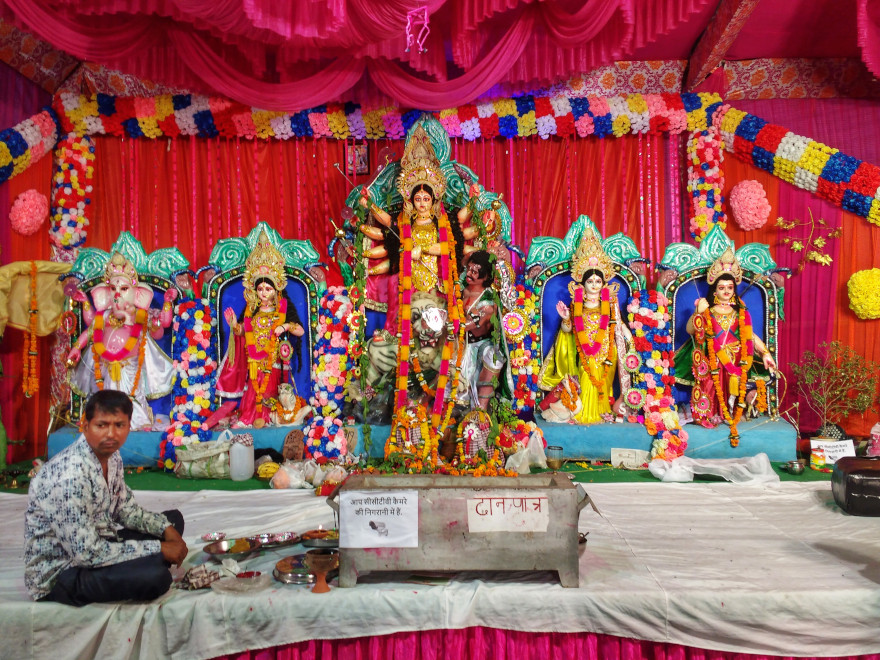
Asthami – 17th October
The Youth Welfare Club of Thapar organizes a Jagran on Asthami evening and continues till late at night. COS is lighted up, girls have got late permi, and the for boys a few more hours with the opposite sex. I have given this event a miss since 2016 since I could not relate to it. I couldn’t understand the bhajans or why the crowd went berserk. This time I decided to go (on persuasion).
At the entrance of OAT, there was a big block of ice, around 2 feet tall rectangular block. There were leaves stuck on it. At the first I couldn’t fathom what could it be. The Bengali in me for whom Pujo is a synonym for food thought it was for the ice lolly or chuskis. Forgive me! I couldn’t have been more wrong. It was a shivling for the God Shiva. Inside I was exposed to different culture. The stage had a huge cutout of Shiva decorated with garlands and detachable scenes of mountains. Just below it was the figurine of Maa Parvati, another form of Maa Durga in a red saree, sitting over her consort – the lion and having the same benign stare at the students who had gathered there to perhaps just enjoy the environment and the night. She is not judging. She knows. One major difference I noticed here was the ghumta or headscarf was over her head. Such a sight was a bit unsettling for me. For years, the depictions of Durga I had seen was of a normal woman – never one with a headscarf, trying to go low. She came to her people, she was one with them. There was grace. In all my years, I had looked at Durga Pujo from a Bengali perspective, this time it was Durga Puja and the North Indian version though vastly different from mine had its own takers.

The jagran would go on till 4 in the morning. I wasn’t very enthusiastic about it to attend till that late. From 10:30 at night, the guards and the people made an announcement that girls will only be allowed to leave with the guards to their hostel. Such an escorted service would be provided at every 90 minutes. I quickly made an exit. Thapar is very serious about not letting the two sexes leave together. If I had delayed then I could only go after the girls had left. Outside I stood for a few minutes – observing and humouring myself with what I was seeing. The machismo, the bravado and the sense of pride of the boys and the guards who were lining up the girls according to their hostels were evident as if they were escorting criminals to their cells after their day out. It sickened me. When I first came to Thapar, the campus was still less lighted – the Haveli, the Dispensary ground were not covered with the harsh gaze of lights. The reason given was safety. Today, the 300-meter stretch was deemed unsafe in spite of the lights and the students moving about that an escort was deemed necessary for the girls. They were celebrating a female goddess inside, singing songs, clapping and devouring her prasad with utmost piety. Outside, a different story was told which border which was edged on by the sycophancy of the few. The girls were led back to their hostels, with their high walls and barbed wires. Walled Garden.
Navami – 18th October
Since we could not enter the Patiala Cantonment without passes and had professors who weren’t too helpful to us in this regard, we decided to go to Chandigarh. That city has around 3 or 4 Durga Pujos and we hoped to see at least some of them if not all. Chandigarh was an unfamiliar place – none of us had been there for much time. We made liberal use of Google Maps to decide our itinerary. Chandigarh is a little more than an hour’s journey from Patiala. The bus will pass through small villages with evocative names like Kauli, Kheri Gandhian, Dharreri Jattan. Everywhere where the eyes went, the landscape was covered in a patchwork of lemon yellow and green fields, sometimes broken only by the transmission poles which criss crossed the horizon with its lines. Somewhere the walls of the houses which happened to be near the National Highway 7 were painted with advertisements of firms to help clear IELTS, TOEFL and getting the much-desired thing in Punjab – a visa for Canada, Australia and UK in that order. Leaving Patiala, one comes across the industrial plant of Federal Moghul which manufactures power trains. From the window, the compound stretched on – the guest house with its well-maintained lawns, the administrative building the front of which has a water fountain working even in the heat of the plains of Northern India. The chimneys, the tin sheds and almost dilapidated sheds for vehicle parking. For a moment, as I watched on I was reminded of my city albeit in a miniature scale – the factory around which an entire town has grown.
Chandigarh has more in common with Jamshedpur than any city I have been to. Jamshedpur was the first industrial planned city in India and Chandigarh which was built about half a decade later shares many aspects – leafy trees covering the roads, the traffic islands, the sign boards of directions to different sectors, each roundabout having its own automatic traffic lights. There are bushes and trees even on the dividers. Greener and cleaner.
Pujo was what I experienced here after a drought of 3 years. Chandigarh Kalibari was good but I couldn’t come to like it as much as it was advertised. There was a mela outside – food stalls, crafts stall, a sitting vendor with roasted peanuts, a young tired looking boy with balloons in his hand for sale. An old man with a long wooden pole from where flutes and other toys jutted out. Yes, it was a Pujo Mela. But somewhere the feeling of it was missing. Perhaps I had expected too much.
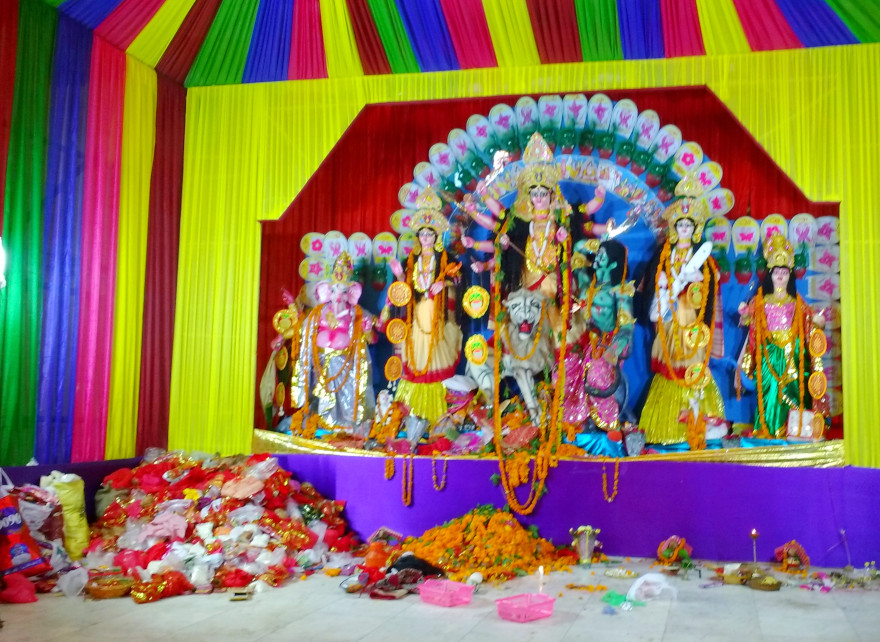
Banga Bhavan at Sector 35C was in my opinion a much better ambience. Small and homely. Not much of a mela rather a mela of food stalls were inside the small premises. Calcutta style egg rolls, fish cutlets, ghugni, fish fry, chicken kebabs and biryani – defying the Navratri this was a mini Bengal in the heart of Chandigarh. The results of a drawing competition for children were pinned against the wall. The theme was Environment or Durga Pujo. A stage was set up for some culturals to be held later on, a man with table full of books of Mario Puzo, Vivekananda, Tagore, Franz Kafka, Dan Brown sat just outside the Pujo mandap. It is difficult to find a Bengali without a taste for such finer things. Banga Bhavan encapsulated all these within their small premises for these few days.

We came back on the last bus home – the 9:45 to Patiala. Yes, home my friend said. No matter how much we chide or scoff at this small town, living here made it feel like home with the knowledge that we are back again at familiar sights and smell. There is a certain small town charm to this place.
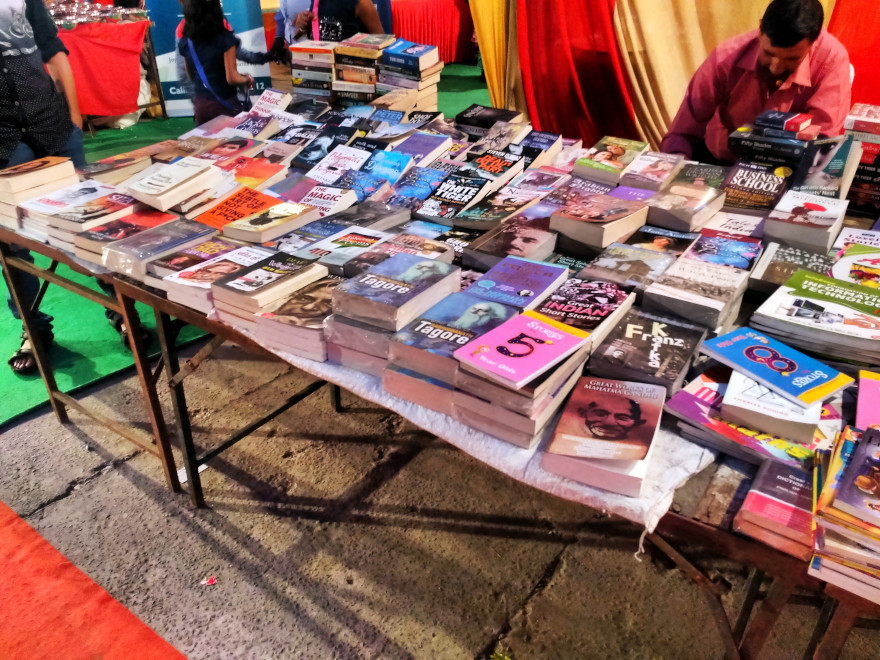
This year I received Pujo photos from Jamshedpur, Durgapur, Chittaranjan Park Delhi and even Manchester, United Kingdom. A veritable assortment of images and memories now abound in my consciousness.
The title of this post Ye Jo Khushi is loose Bengali translation of ই জে উল্লাস which accompanied my status on Navami. I received quite a few curious messages regarding this. So, here, this post is what it stands for.
If there is one regret which I have then it would be my inability to take better photos in order to merely try to bring out the vibrancy of this festival. Perhaps next time…
Like it? Subscribe
